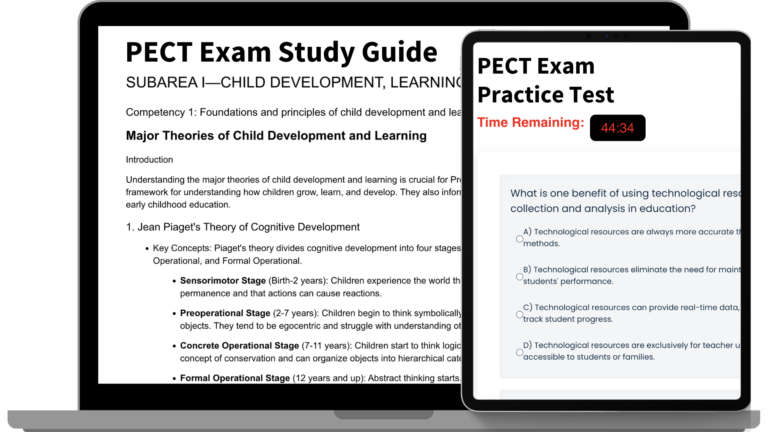PECT PreK-4 Module 2
Welcome to the PECT PreK-4 Module 2 page, an essential resource for future elementary school teachers in Pennsylvania seeking certification. This module is a vital part of your path to becoming an educator, focusing on the core subjects of Language and Literacy Development, Social Studies, Arts, and Humanities. Here, we provide a wealth of information and tools specifically designed to help you excel in Module 2. You will discover comprehensive study guides, practice questions, and valuable insights on mastering the content of this module. Our aim is to furnish you with all the necessary resources to confidently navigate through the intricacies of Module 2. As you embark on this part of your educational journey, we are here to ensure you are fully equipped and poised for success. Let’s embark on this learning adventure together, making sure you are well-prepared and self-assured as you take on the PreK-4 PECT exam.
Resource Links
Below you will find links to resources that we have created to help you prepare for your exam:
About The PreK-4 PECT Module 2 Exam
| PreK-4 Module 2 | Details |
|---|---|
| Test Design | Computer-based test (CBT) |
| Number of Questions | 45 selected-response items |
| Time | 75 minutes, plus 15 minutes for a CBT tutorial |
| Reference Materials | Glossary of common acronyms used in the field |
| Subarea 1 | I. Language and Literacy Development (66%, Objectives 6–9) |
| Subarea 2 | II. Social Studies, Arts, and Humanities (34%, Objectives 10–11) |
What's On The Test
In order to be fully prepared for Module 2, it’s essential to have a clear understanding of its components. As indicated in the table above, Module 2 of the PreK-4 exam is organized into two primary sections:
- Language and Literacy Development, and
- Social Studies, Arts, and Humanities
It’s important to note the weightage of these subareas. Subarea I, which covers Language and Literacy Development, constitutes 66% of your total Module 2 score. Subarea II, encompassing Social Studies, Arts, and Humanities, accounts for the remaining 34%. This distribution implies that a greater portion of your study and preparation time should be focused on Language and Literacy Development. However, it’s crucial not to underestimate the importance of the Social Studies, Arts, and Humanities section. Next, we will delve into the specific topics within each subarea, equipping you with the knowledge and understanding required to excel in your PreK-4 Exam Module 2.
Subarea I: Language and Literacy Development
Objective 6 of Module 2 for the PreK-4 PECT Exam focuses on understanding the foundations of research-based, standards-based literacy instruction and assessment for PreK–4 students in language development. Here is a summary of the key points and topics covered in this objective:
- Pennsylvania’s PreK–4 Learning Standards in Language Arts
- Scientific-Based Reading Research
- Best Practices in Early and Emergent Literacy
- Creating a Literate Environment
- Selecting Instructional Materials
- Instruction and Interventions in Language Skills
- Supporting Emergent Literacy Development
- Assessment in Language Development
This objective is essential for educators preparing for the PreK-4 PECT Exam as it covers fundamental concepts related to literacy instruction and assessment for young learners.
Objective 7 of the PreK-4 PECT Exam focuses on understanding assessment, instruction, and intervention for PreK–4 students in emergent literacy and beginning reading, including the development of phonemic awareness and phonics skills. Here is a summary of the key points and topics covered in this objective:
Instruction and Interventions in Basic Concepts of Print
Phonological Processing and Phonological Awareness Skills
Phonemic Awareness Skills
Letter Knowledge and Skills
Linguistic Units in Phonics
Phonics Instruction
Sight Words and Inflectional Morphemes
Assessment in Emergent Literacy and Beginning Reading Skills
This objective is crucial for educators preparing for the PreK-4 PECT Exam as it covers essential concepts related to assessing, instructing, and intervening in emergent literacy and beginning reading skills for young students.
Objective 8: Assessment, Instruction, and Intervention for PreK–4 Students in Reading Fluency, Vocabulary Development, and Reading Comprehension
- Understanding automaticity and reading fluency, including its role in reading comprehension.
- Recognizing key indicators of reading fluency (accuracy, rate, and prosody) and factors that can disrupt it.
- Instruction and interventions in reading fluency, including building accuracy, rate, and prosody.
- The role of vocabulary in listening and reading comprehension.
- Strategies for developing early and robust oral vocabulary.
- Instruction and interventions in vocabulary development, including word-learning strategies and multiple-meaning words.
- Factors affecting reading comprehension and strategies to facilitate it.
- Instruction and interventions in comprehension strategies for literary and informational texts.
- Assessment in reading fluency, vocabulary development, and reading comprehension.
Objective 9: Assessment, Instruction, and Intervention for PreK–4 Students in Academic Language and in Listening, Speaking, and Writing Skills
- Recognizing challenges of academic language for young children and strategies to build connections between early language and preliteracy skills.
- Understanding English language characteristics, parts of speech, sentence structures, and language conventions.
- Instruction and interventions in academic language for listening, speaking, reading, and writing.
- Strategies for teaching communication in different languages and through assistive devices.
- Instruction and interventions in listening skills.
- Instruction and interventions in speaking skills.
- Instruction and interventions in writing skills for different purposes.
- Phonological influences on inventive spelling and instruction in spelling.
- Instruction and interventions in research skills.
- Assessment in academic language, listening, speaking, and writing skills.
Subarea II: Social Studies, Arts, and Humanities
Objective 10: Developmental Foundations and Instruction in Social Studies
- Developmental foundations and main themes of social studies learning.
- Criteria and techniques for selecting, designing, adapting, and using teaching materials and activities.
- Strategies for implementing developmentally appropriate instruction in social studies.
- Assessment in social studies, including selecting appropriate assessments and interpreting results.
- Strategies for engaging children in civic competence and civic values.
- Strategies and resources for teaching geography concepts and using maps.
- Strategies and resources for teaching world, U.S., and Pennsylvania history.
- Strategies for teaching government and economics concepts.
Objective 11: Developmental Foundations and Instruction in Arts and Humanities
- How child development influences learning in arts and humanities.
- Criteria and techniques for selecting, designing, and using teaching materials and activities.
- Strategies for implementing developmentally appropriate instruction in arts and humanities.
- Assessment in arts and humanities, including selecting appropriate assessments and interpreting results.
- Basic elements, concepts, terms, and themes associated with dance, music, creative drama, and the visual arts.
- Developmentally appropriate experiences for engaging children in producing, discussing, evaluating, and enjoying various forms of art.
- Understanding how the arts represent different ways of perceiving and interpreting the world and making connections between arts and humanities and other disciplines.



